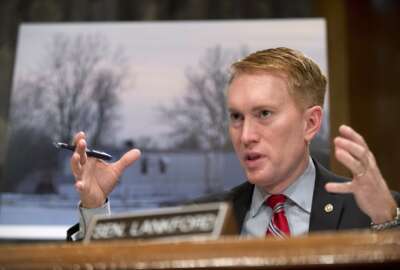
OPM says it’ll help agencies re-skill federal employees for jobs of the future
OPM is encouraging agencies to think about how many people they'll need to accomplish their missions in the future — and how they can retrain their employees to...
The Trump administration’s call on agencies to reexamine the federal workforce and think about ways they can become more effective and efficient isn’t just a scare tactic in the name of “government reorganization.”
The nature of federal jobs is changing. Automation and artificial intelligence are coming, and the Office of Personnel Management wants to make sure agencies and their employees are ready when the day comes.
In the coming months, OPM will have more guidance for agencies to better prepare their employees to handle new kinds of work, the agency’s acting director, Kathleen McGettigan, acting OPM director, said.
“The federal government will not be immune to those changes,” she said Tuesday during a speech at a Government Executive event in Washington. “These changes will create more effective and efficient solutions for even routine work, and we have to be prepared for that. We must think about how we can re-skill or retrain our current employees and up-skill other employees who can help us use this automation better.”
Agencies spent the past year examining exactly how many people they’ll need to perform specific tasks. New professional development opportunities will be crucial, McGettigan said, as automation takes the place of much of government’s current transactional work.
“We can’t lose sight of the need to maintain and sustain a culture that cultivates a high performance workforce while these changes are occurring,” she said. “For example, training and employee development opportunities do encourage good employee performance. They strengthen job-related skills and competencies and help employees keep up with the changes in the workplace.”
OPM’s call for agencies to redefine their work and find the right balance between “technology and human collaboration” represents a significant shift in thinking. OPM recently documented that shift in its new strategic plan, which the agency released last month, and in the Quadrennial Federal Workforce Priorities report.
The report — the first of its kind — describes recent research on new trends that will impact the federal workforce.
Though OPM doesn’t predict automation will completely take over all work activities all at once, agencies should start thinking about how they adapt to a new world. Developing soft skills in the federal workforce has and will continue to become more important, it added.
The president’s workforce plan also gives agencies an opportunity to re-imagine the way they manage human capital, McGettigan said.
In asking agencies to evaluate their workforce and their current practices for hiring and retaining top talent, OPM has noticed that some organizations have created unnecessary challenges, McGettigan said.
“We’ve seen examples of additional steps and procedures that agencies have implemented … that are not required by law or OPM reg[ulations],” she said. “These additional requirements established by agencies can result in unique, agency-specific challenges, and those challenges can take time to address. We’re calling on agencies to look at their internal policies and procedures and to try to find opportunities to become more efficient and effective.”
A head start
Some agencies have a little experience with doing the kind of transition and workforce planning that OPM and the Trump administration are asking for now.
The National Geospatial-Intelligence Agency got a head start a few years ago. The agency stood up talent acquisition center and an office that deals specifically with employee development.
NGA’s Office of Talent Development looks at specific employees and their skills and evaluates more broadly where individuals will best fit the agency and its mission needs.
“We’re used to managers being able to select people and then put them in the positions that they want to put them in,” said Liz Hoag, senior adviser for personnel policy at NGA. “Now we have a broader scope for the agency.”
To get started, NGA first took a look at its billet structure for full time employees and other “apprentices.”
“Then you can start putting faces to those spaces and bringing [them] in,” said Dale Buckholz, deputy director of human development at NGA. “As you bring in those faces, then you can moderate and you have levers to move your workforce based on things like a VERA/VSIP [Voluntary Early Retirement Authority/Voluntary Separation Incentive Payment], based on retirements and looking at your entire spectrum.”
NGA, however, differs significantly from most other agencies. Not only is its mission highly technical and focused on careers in science, technology, engineering and math (STEM), but it also moved to a pay-for-performance system in the 1990s.
“It is different,” Hoag said. “Everybody doesn’t get a promotion every single year. You might have four promotions in your entire career, and that is a culture change. It makes us recognize performance in other ways, through awards, through bonuses, through opportunities just to pat someone on the back or give them an experience they wouldn’t otherwise be able to take advantage of.”
The agency halved funding for performance awards in two parts. One half goes toward end-of-year bonuses, while NGA uses the other half throughout the entire year, Hoag said.
“We keep 50 percent out that is used throughout the year to try … to recognize as soon as performance is occurring to quickly step in,” she said. “We’re not as quick as one might wish to be. We are working on it.”
Despite its differences, NGA believes some of the lessons it learned in recent years can apply to other agencies.
“It’s not so much that we do things differently,” Hoag said. “Our pay structure works for us. Our pay-for-performance structure works for NGA. It wouldn’t necessarily work for everybody else, but maybe there are flexibilities within the current OPM authorities that other people are following that could. … There are a lot of flexibilities that have been built in and we just didn’t know about them.”
Copyright © 2025 Federal News Network. All rights reserved. This website is not intended for users located within the European Economic Area.
Nicole Ogrysko is a reporter for Federal News Network focusing on the federal workforce and federal pay and benefits.
Follow @nogryskoWFED
Related Stories






